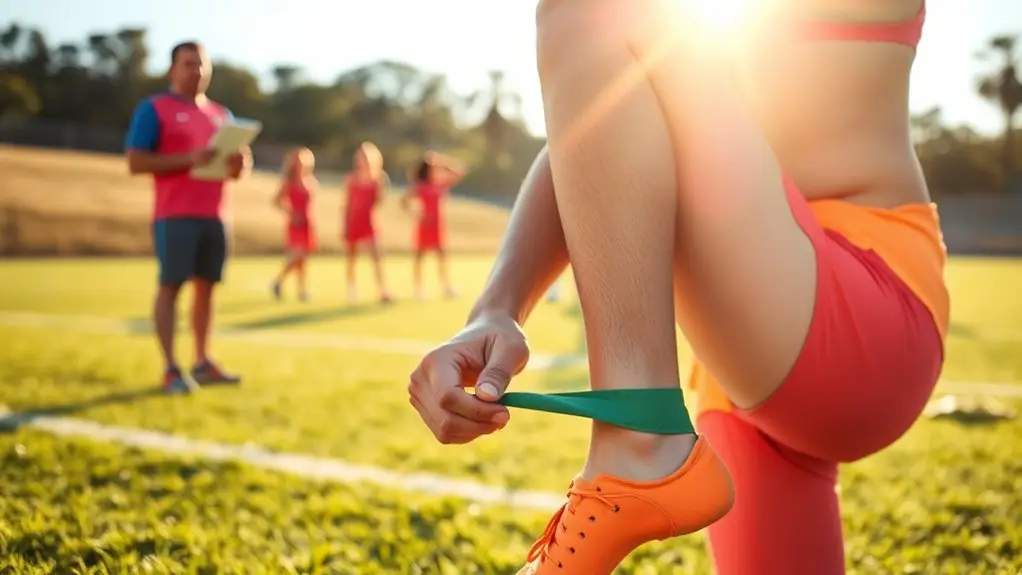To optimize recovery as an endurance cyclist, prioritize post-ride nutrition with carbs and protein to replenish glycogen and repair muscles. Hydrate immediately with water or electrolytes to restore balance. Quality sleep is essential for muscle repair, so aim for consistent sleep schedules. Incorporate active recovery techniques like low-intensity rides and stretching to enhance flexibility. Don't overlook mental recovery strategies that can rejuvenate your mind. Keep going to discover more effective practices for better performance.
The Importance of Post-Ride Nutrition
After a long ride, it's vital to refuel your body with the right nutrients. You've pushed your limits, and now it's time to embrace the freedom of recovery. Focus on post-ride carbohydrates; they're important for replenishing glycogen stores and kick-starting your recovery. Think about a banana or whole-grain toast with some honey—simple, effective, and satisfying.
But don't forget about protein timing. Consuming protein within 30 minutes after your ride helps repair those muscles you've worked so hard. A protein shake or yogurt can be a quick fix, allowing you to get back to enjoying life. Adequate protein intake reduces soreness and accelerates recovery time, ensuring that you feel your best for your next ride.
Balancing these macronutrients not only supports your recovery but also empowers you to keep riding strong. So grab that snack, feel the energy flowing back into your body, and get ready for your next adventure. Freedom awaits, and you're just getting started!
Hydration Strategies for Optimal Recovery
While you may feel drained after a long ride, proper hydration is essential for your recovery. You've pushed your limits, and your body needs to replenish fluids to restore balance. Start hydrating immediately post-ride; this is vital hydration timing. Aim to drink at least 16-24 ounces of water or an electrolyte-rich beverage within the first hour.
Maintaining your electrolyte balance is equally important. After sweating it out, your body craves sodium and potassium to help muscle function and prevent cramps. Consider incorporating electrolyte tablets or drinks designed for recovery.
As you sip, listen to your body. If you're feeling thirsty, you're already behind. Make hydration a priority, not an afterthought, and you'll bounce back faster. Staying hydrated supports the freedom on the bike that comes from knowing you've fueled your body right. Embrace these hydration strategies, and you'll be ready to tackle your next adventure with vigor.
The Role of Sleep in Endurance Recovery
As you push your limits on the bike, don't underestimate the power of a good night's sleep for recovery. Sleep quality and sleep duration are essential for restoring your body and enhancing performance. When you prioritize rest, you allow your muscles to repair and replenish energy stores, setting you up for your next ride. Quality sleep also reduces inflammation, improving strength and endurance, which are vital for endurance cyclists.
To optimize your sleep, pay attention to your circadian rhythm. Try to go to bed and wake up at consistent times, aligning your sleep with natural light patterns. Creating a sleep environment that's dark, quiet, and cool can further enhance your rest. Consider using blackout curtains or white noise machines to eliminate distractions.
Active Recovery Techniques to Consider
When it comes to recovery, incorporating active techniques can make a big difference. You might consider low-intensity cycling to keep your legs moving, along with stretching and mobility exercises to enhance flexibility. These methods not only help in recovery but also prepare your body for future rides. Additionally, engaging in active recovery can significantly boost blood flow, which is crucial for effective recovery.
Low-Intensity Cycling
One effective way to enhance recovery after intense rides is through low-intensity cycling. This active cycling technique lets you pedal at a relaxed pace, helping to flush out lactic acid while promoting blood flow. You'll experience several endurance benefits, including:
- Improved circulation: Boosts oxygen delivery to muscles, speeding up recovery.
- Reduced muscle soreness: Gentle movement helps alleviate stiffness and discomfort.
- Mental refreshment: Enjoying a leisurely ride can clear your mind and re-energize your spirit.
- Building a habit: Incorporating low-intensity sessions into your routine fosters consistency and freedom in your cycling journey.
Stretching and Mobility Exercises
Incorporating stretching and mobility exercises into your recovery routine can greatly enhance your performance as an endurance cyclist. Dynamic stretching helps improve flexibility and range of motion, while foam rolling releases muscle tension, promoting faster recovery. By using these techniques, you'll feel freer and more agile on your rides.
Here's a quick guide to get you started:
| Exercise | Purpose | Duration |
|---|---|---|
| Dynamic Stretching | Increases flexibility | 10-15 minutes |
| Foam Rolling | Reduces muscle soreness | 5-10 minutes |
| Hip Openers | Enhances hip mobility | 5 minutes |
| Upper Body Stretch | Relaxes tight upper muscles | 5 minutes |
Incorporate these into your routine for a smoother ride!
Stretching and Mobility Exercises
Although you might focus heavily on your cycling performance, neglecting stretching and mobility exercises can hinder your recovery and overall progress. Incorporating these practices into your routine not only enhances flexibility but also prevents injuries, giving you the freedom to ride more.
Neglecting stretching and mobility can impede your cycling recovery and performance; prioritize them for better flexibility and injury prevention.
Here are some essential strategies to contemplate:
- Dynamic stretches: Engage your muscles before rides to improve range of motion and reduce stiffness.
- Foam rolling: Use a foam roller post-ride to release muscle tension and increase blood flow for faster recovery, which is essential for muscle recovery benefits.
- Targeted mobility exercises: Focus on hip and ankle mobility to enhance your cycling efficiency and comfort.
- Consistency: Make stretching and mobility a regular part of your routine, ensuring you're always ready to hit the road.
Incorporating Rest Days Into Your Training Plan
Balancing your training with adequate rest days is essential for optimizing performance and recovery. These days aren't just about kicking back; they're vital for muscle repair and mental rejuvenation. Incorporating rest days into your training schedule can lead to enhanced endurance, greater strength gains, and reduced injury risk. Moreover, understanding the role of rest days in training can significantly impact your overall success and well-being.
Here's a quick reference to help you understand the rest day benefits:
| Rest Day | Benefit | Frequency |
|---|---|---|
| Active | Light activity (yoga) | 1-2 times/week |
| Passive | Complete rest | 1 time/week |
| Recovery | Low-intensity ride | Every 3-4 weeks |
Make sure you plan your rest strategically within your training schedule. Listen to your body, and don't hesitate to adjust your routine. Embrace the freedom that comes with knowing you're giving your body the time it needs to recover and thrive!
Mental Recovery: Strategies to Rejuvenate Your Mind
While physical recovery is essential for endurance cyclists, mental recovery is equally important for maintaining a high level of performance. To keep your mind sharp and free, you can incorporate several strategies into your routine:
Mental recovery is vital for endurance cyclists, complementing physical recovery to sustain peak performance.
- Practice mindfulness techniques: Spend time focusing on your breath or surroundings to reduce stress and enhance clarity.
- Engage in positive visualization: Imagine your success during rides; this can boost your confidence and motivation.
- Take breaks from technology: Disconnecting allows your mind to reset and rejuvenate, fostering creativity and focus.
- Incorporate leisure activities: Pursue hobbies you love, whether it's reading, painting, or just being in nature—these experiences can refresh your mental state. Additionally, mindfulness meditation can enhance focus and reduce anxiety, further supporting your mental recovery process.
Frequently Asked Questions
How Do I Know if I'm Overtraining?
Imagine you're feeling unusually fatigued after your workouts, even after a good night's sleep. That could be a sign of overtraining. To assess if you're overtraining, keep an eye out for symptoms like persistent fatigue, irritability, or decreased performance. Conduct a fatigue assessment by tracking your energy levels daily. If you notice a consistent decline, it's time to reconsider your training intensity and give your body the freedom to recover.
What Supplements Aid in Recovery for Cyclists?
When you're looking to boost your recovery, consider incorporating protein powders and electrolyte drinks into your routine. Protein powders can help repair muscle tissue after those long rides, while electrolyte drinks replenish essential minerals lost through sweat. You want to feel free and energized for your next adventure, right? These supplements can be the key to enhancing your recovery, allowing you to hit the road again sooner and stronger.
How Can I Assess My Recovery Progress?
Imagine your body as a finely tuned instrument, playing the symphony of performance. To assess your recovery progress, focus on recovery metrics like heart rate variability and sleep quality. Keep a journal or app for performance tracking, noting how you feel after workouts. Just like tuning a guitar, small adjustments can lead to beautiful harmony. Trust the process, listen to your body, and embrace the freedom that comes with knowing your progress.
Should I Use Ice Baths After Long Rides?
Using ice baths after long rides can be beneficial, especially when it comes to reducing muscle soreness and inflammation. Cold exposure helps constrict blood vessels, which can speed up recovery. If you enjoy the invigorating feeling of an ice bath, it might be worth incorporating into your routine. Just remember, balance is key; don't overdo it. Listen to your body, and find what works best for your recovery journey without any restrictions.
What Are the Signs of Dehydration During Recovery?
Dehydration can sneak up on you like a shadow at dusk. If you're feeling dizzy, fatigued, or experiencing dry mouth, those are clear dehydration symptoms. You might also notice dark urine or headache creeping in. To combat this, it's crucial to implement hydration strategies, like sipping water regularly and consuming electrolytes. Staying aware of your body's signals helps you enjoy your rides without being held back by fatigue or discomfort.




